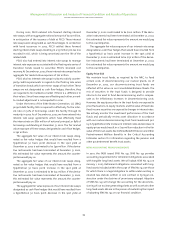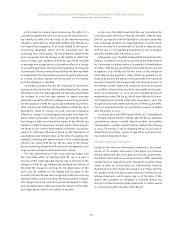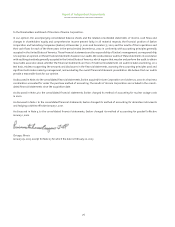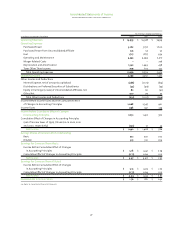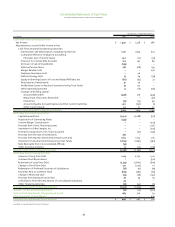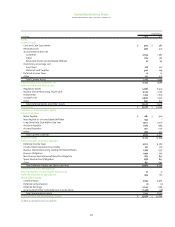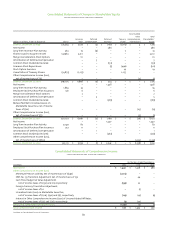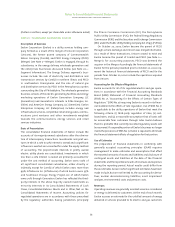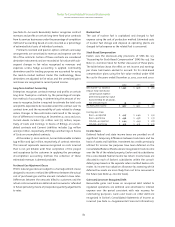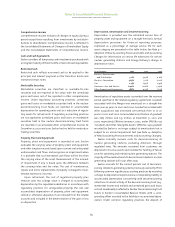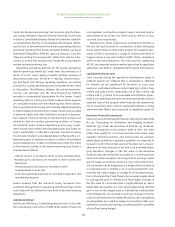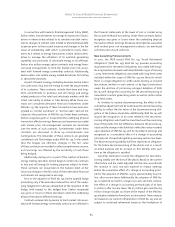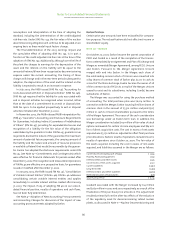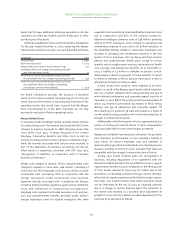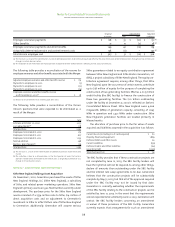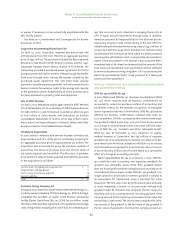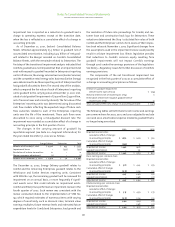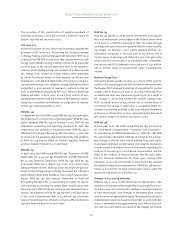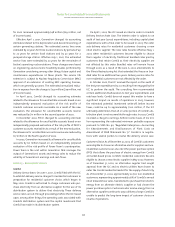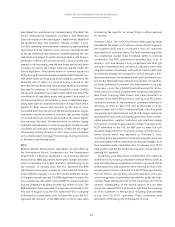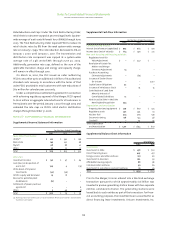ComEd 2002 Annual Report Download - page 86
Download and view the complete annual report
Please find page 86 of the 2002 ComEd annual report below. You can navigate through the pages in the report by either clicking on the pages listed below, or by using the keyword search tool below to find specific information within the annual report.
funds into the decommissioning trust accounts plus the finan-
cial activity reflected in Nuclear Decommissioning Trust Funds
in Exelon’s Consolidated Balance Sheets will,over time,establish
a corresponding liability in accumulated depreciation reflect-
ing the cost to decommission the nuclear generating stations
previously owned by PECO.Exelon will adopt SFAS No.143,“Asset
Retirement Obligations”(SFAS No. 143) as of January 1, 2003. See
“New Accounting Pronouncements” within this note for a dis-
cussion as to how this standard will change the accounting for
nuclear decommissioning costs.
Regulatory accounting practices for the nuclear generating
stations previously owned by ComEd were discontinued as a
result of an ICC order capping ComEd’s ultimate recovery of
decommissioning costs. See Note 11—Nuclear Decommission-
ing and Spent Fuel Storage regarding regulatory accounting
practices for nuclear generating stations transferred by ComEd
to Generation. The difference between the current decommis-
sioning cost estimate and the decommissioning liability
recorded in accumulated depreciation for the former ComEd
operating stations is being amortized to depreciation expense
on a straight-line basis over the remaining lives of the stations.
The current decommissioning cost estimate (adjusted annually
to reflect inflation) for the former ComEd retired units recorded
in deferred credits and other liabilities is accreted to deprecia-
tion expense. Financial activity of the decommissioning trust
related to Exelon’s nuclear generating stations no longer
accounted for under common regulatory practices (e.g., invest-
ment income and realized and unrealized gains and losses on
trust investments) is reflected in Nuclear Decommissioning
Trust Funds in Exelon’s Consolidated Balance Sheets with a cor-
responding gain or expense recorded in Exelon’s Consolidated
Income Statement or in other comprehensive income.The offset
to the financial activity in the decommissioning trust funds is
summarized as follows:
– Interest income is recorded in other income and deductions,
– Realized gains and losses are recorded in other income and
deductions,
– Unrealized gains and losses are recorded in other
comprehensive income,and
– Trust fund operating expenses are recorded in operation and
maintenance expense
Exelon believes that the amounts being recovered from
customers through electric rates along with the earnings on the
trust funds will be sufficient to fully fund its decommissioning
obligations.
Capitalized Interest
Exelon uses SFAS No.34,“Capitalizing Interest Costs,”to calculate
the costs during construction of debt funds used to finance its
non-regulated construction projects. Exelon recorded capital-
ized interest of $20 million, $17 million and $2 million in 2002,
2001 and 2000,respectively.
Allowance for Funds Used During Construction (AFUDC) is
the cost, during the period of construction, of debt and equity
funds used to finance construction projects for regulated oper-
ations. AFUDC is recorded as a charge to Construction Work in
Progress and as a non-cash credit to AFUDC that is included in
Other Income and Deductions. The rates used for capitalizing
AFUDC are computed under a method prescribed by regulatory
authorities (see Note 6—Supplemental Financial Information).
Capitalized Software Costs
Costs incurred during the application development stage of
software projects for software that is developed or obtained
for internal use are capitalized. At December 31, 2002, 2001
and 2000, capitalized software costs totaled $335 million, $240
million and $285 million, respectively, net of $156 million, $85
million and $53 million of accumulated amortization, respec-
tively. Such capitalized amounts are amortized ratably over the
expected lives of the projects when they become operational,
not to exceed ten years. Certain capitalized software is being
amortized over fifteen years pursuant to regulatory approval.
Derivative Financial Instruments
Exelon accounts for derivative financial instruments under SFAS
No. 133, “Accounting for Derivatives and Hedging Activities”
(SFAS No. 133). Under the provisions of SFAS No. 133, all deriva-
tives are recognized on the balance sheet at their fair value
unless they qualify for a normal purchases and normal sales
exception. Normal purchases and normal sales are contracts
where physical delivery is probable, quantities are expected to
be used or sold in the normal course of business over a reason-
able period of time,and price is not tied to an unrelated under-
lying derivative. Changes in the fair value of the derivative
financial instruments thatdo not qualify for a normal purchase
and normal sales exception are recognized in earnings unless
specific hedge accounting criteria are met. A derivative finan-
cial instrument can be designated as a hedge of the fair value of
a recognized asset or liability or of an unrecognized firm com-
mitment (fair value hedge), or a hedge of a forecasted transac-
tion or the variability of cash flows to be received or paid related
to a recognized asset or liability (cash flow hedge). Changes in
the fair value of a derivative that is highly effective as, and is
designated and qualifies as, a fair value hedge, along with the
gain or loss on the hedged asset or liability that is attributable
to the hedged risk, are recorded in earnings.Changes in the fair
value of a derivative that is highly effective as,and is designated
as and qualifies as a cash flow hedge are recorded in other com-
prehensive income,until earnings are affected by the variability
of cash flows being hedged.
Notes To Consolidated Financial Statements
exelon corporation and subsidiary companies
84


